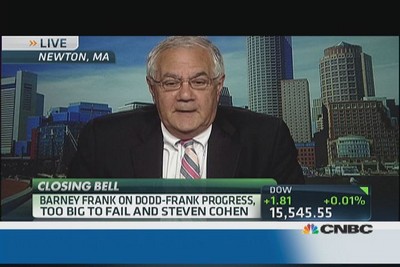They are stalling! Reinstate Glass-Steagall NOW before it's too frickin late!
Barney Frank dismisses calls for Glass-Steagall redux
By: Drew Sandholm | Producer
|
|
|
Dodd-Frank: Slow but steady
Monday, 22 Jul 2013 | 4:17 PM ETRegulators have written 14,000 pages and finalized 155 rules of the Dodd-Frank Act since Washington vowed to fix Wall Street, reports CNBC's Kayla Tausche. Retired Mass. Rep. Barney Frank (D) discusses whether the bill can accomplish that.
Retired Rep. Barney Frank on Monday dismissed calls to bring back the Glass-Steagall Act of 1933, a Depression-era law that divided commercial and investment banking, arguing that it fails to regulate derivatives trading or prevent risky loans and mortgages.
"The point of Glass-Steagall is we'll only let banks do certain things, but very damaging things were done in the economy outside of banks," said Frank. The Massachusetts Democrat was an architect of the Dodd-Frank reform bill in the wake of the 2008 financial crisis following the collapse of the subprime mortgage market. President Barack Obama signed the bill into law in 2010 .
"AIG was not a bank. It wouldn't have been affected by Glass-Steagall," Frank said. "Much of what we did was to put some regulation on derivatives and to require risk retention."
A group of senators, including Massachusetts Democrat Elizabeth Warren and Arizona Republican John McCain, are seeking to bring back elements of Glass-Steagall, though. Calls to resurrect the law come amid a fierce debate over whether regulators have done enough to end a policy of "too big to fail," which allows large institutions to receive considerable government assistance if they get into trouble.
Frank said Dodd-Frank had adequately addressed that issue, noting that it would now take an act of Congress to bail out a bank, as the government did at the height of the financial crisis.
"We do say in the bill that if a large institution fails, we will abolish it, liquidate it, then the federal officials step in and deal with the consequences, but if in the course of dealing with the consequences, they have to spend any money, they are mandated to get it all back by assessing the largest financial institutions," Frank said. "We did end 'too big to fail.' "
"There are always going to be institutions—even if you split everyone in half or in thirds—there will be institutions, which if they couldn't pay enough of their debts, it could cause problems. So we do recognize that there are some institutions that are too big to ignored if they fail," Frank said, reiterating that a large bank in trouble would be dissolved and liquidated.
Treasury Secretary Jack Lew said last week that the U.S. is committed to ending "too big to fail." He said that Dodd-Frank's "core elements" will be implemented by year-end—roughly three years after the measure became law.
—By CNBC's Drew Sandholm. Follow him on Twitter
@DrewSandholm


No comments:
Post a Comment